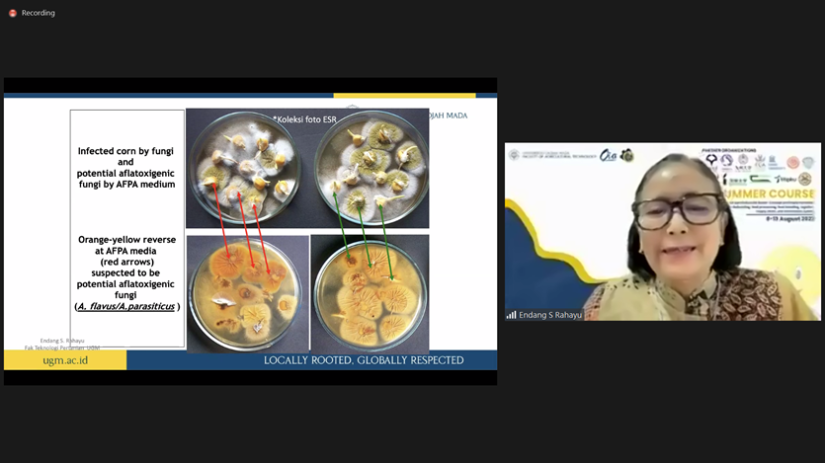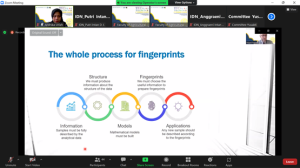
On August 12th 2022, Summer course entered its fourth day. On the fourth day, there are 4 main events, the first one is the first session by Dr. Widyastuti Setyaningsih, S.T.P., M.Sc. Second session by Prof. Dr. Ir. Endang Sutriswati Rahayu, M.S. Third session by Prof. Miguel Palma and lastly the fourth session by Asst. Prof. Thanit Puthpongsiriporn, Ph.D.
 The series of events on the fourth day started at 07.55, which started with an opening by the master of ceremonies. Then continued with the first session by Dr. Widyastuti Setyaningsih, S.T.P. with “Application of experimental designs to develop analytical methods for bioactive compounds in foods” as topic. This session was also accompanied by Ashri Nugrahini, S.T.P., M. Sc.. Dr Widyastuti starts the topic with how bioactive compounds in rice can be separated with chromatographic methods. And then this method can be replaced with other experimental designs. The experimental design can be applied using analytical extraction techniques, namely MAE and PLE and analytical separation techniques, namely HPLC-PDA and UPLC-PDA-FD.
The series of events on the fourth day started at 07.55, which started with an opening by the master of ceremonies. Then continued with the first session by Dr. Widyastuti Setyaningsih, S.T.P. with “Application of experimental designs to develop analytical methods for bioactive compounds in foods” as topic. This session was also accompanied by Ashri Nugrahini, S.T.P., M. Sc.. Dr Widyastuti starts the topic with how bioactive compounds in rice can be separated with chromatographic methods. And then this method can be replaced with other experimental designs. The experimental design can be applied using analytical extraction techniques, namely MAE and PLE and analytical separation techniques, namely HPLC-PDA and UPLC-PDA-FD.
The second lecture was given by Prof. Dr. Ir. Endang Sutriswati Rahayu, M.S. entitled “Control Technology Against Contaminants Using Beneficial Microorganisms To Improve The Quality Of Food”. This session started at 10.00 AM GMT +7 and this session also was accompanied by Ardhika Ulfah, S.TP., M.Sc. as a moderator. She began her lesson by explaining that the keyword for her lecture is contaminant (mycotoxin) and beneficial microorganism (lactic acid bacteria). Mycotoxin like aflatoxin can contaminate food, affecting health and giving a bad effect in growth like stunting, underweight, and another growth problem.Microorganisms can be used to control mycotoxin and it’s also environmentally friendly if we compare it to pesticides. Lactic acid bacteria (LAB) is one of the microorganisms that can be used. LAB is capable of binding aflatoxins and also can prevent the growths of bacterial toxins and their producers.
 In the third session, Prof. Miguel Palma explained the material about Chemometric Tools in Food Analysis : from Numerical Data to Fingerprints. This session was moderated by Ardhika Ulfah, S.T.P., M.Sc.. Prof. Miguel Palma, in this session begins with an explanation regarding the analysis of the web browser’s working system so that it can meet the needs of its users through the collection of user behavior data. This can be applied to the food industry by collecting data so that fruit or vegetables can be sorted without touching or damaging them based on an existing data base. Another use in the food industry is that fingerprints enable simple, fast, and automated answers that can assist identification and quality control in food companies.
In the third session, Prof. Miguel Palma explained the material about Chemometric Tools in Food Analysis : from Numerical Data to Fingerprints. This session was moderated by Ardhika Ulfah, S.T.P., M.Sc.. Prof. Miguel Palma, in this session begins with an explanation regarding the analysis of the web browser’s working system so that it can meet the needs of its users through the collection of user behavior data. This can be applied to the food industry by collecting data so that fruit or vegetables can be sorted without touching or damaging them based on an existing data base. Another use in the food industry is that fingerprints enable simple, fast, and automated answers that can assist identification and quality control in food companies.
The fourth session which was also the the last session on the 4th day of summer course is held by Asst. Prof. Thanit Puthpongsiriporn, Ph.D. With the topic “Food Product Traceability Smart Technology in Agro Industrial Sector (Concept and Implementation”. Traceability is an ability to identify the past or current location of an item as well as to know the item’s history. There are some traceability technologies which can be different depending on its fundamentals, the example is unique identification, automatic data capturing and data sharing. The main objective of traceability is to give evidence of food safety. Increasing customer services and cost reudition.
